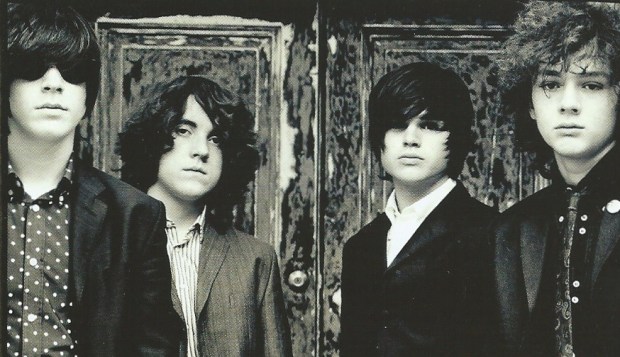The meaning of the Strypes
 My friend Mats Olsson, a columnist with the Swedish daily paper Expressen, asked me an interesting question the other day, knowing that I was listening to Snapshot, the debut album from the Strypes: “Any theories why a young, British, Dr Feelgood-ish band comes along every 20 years or so?”
My friend Mats Olsson, a columnist with the Swedish daily paper Expressen, asked me an interesting question the other day, knowing that I was listening to Snapshot, the debut album from the Strypes: “Any theories why a young, British, Dr Feelgood-ish band comes along every 20 years or so?”
I gave him a slightly facetious answer: “To remind Americans of their heritage, probably.” But even if Mats’s chronology was a big askew, along with his geography (Cavan, the Strypes’ home town, is in the Republic of Ireland), it’s certainly worth thinking about why this quartet of teenagers has come along to evoke so precisely the spirit of the Rolling Stones, the Pretty Things, the Downliners Sect and the Eel Pie Island scene back in 1963 and the Canvey Island sound of the Feelgoods and Eddie and the Hot Rods in the mid-Seventies.
It’s a matter in which I have a personal interest, since — like hundreds of others — back in the early Sixties I was a member of one of those first-generation English R&B bands, with a repertoire largely borrowed from Chuck Berry, Bo Diddley, Muddy Waters and Jimmy Reed. And a decade later, working as an A&R man for Island Records, I made the decision not to pursue an interest in Dr Feelgood — something that’s caused me the occasional sleepless night over the past 30-odd years, and certainly every time that excellent Julien Temple documentary Oil City Confidential gets shown on TV.
There were three reasons why I didn’t try to sign the Feelgoods. First, they were virtually promised to United Artists’s Andrew Lauder, who had been courting them with some ardour. Second, I wasn’t convinced by their original material. Third, I couldn’t really see a proper long-term future for something that, in essence, I felt we’d all lived through a decade earlier.
I was wrong on the last count in particular. I was certainly waiting for something new to happen, a sense of frustration mounting by the month as I waded through unsolicited prog-rock and singer-songwriter demo tapes, but I failed to recognise that the Feelgoods represented an important first stage on the route to whatever that new something was going to be. They didn’t need to be the last word in original thought.
Something similar could turn out to be true of the Strypes, whose music is based firmly on those earlier templates. The first thing to be said is that Ross Farrelly, Josh McClorey, Pete O’Hanlon and Evan Walsh may be aged 16 and 17, but so were we, back in 1964, and it didn’t stop us from having a decent stab at this kind of R&B. And the quartet from Cavan are very good at it, indeed better than we were in their versions of both sides of a great Diddley 45, “You Can’t Judge a Book By Its Cover” and “I Can Tell” (in which they replace the great original guitar riff with their own, equally good).
Farrelly clearly has what it takes to be a convincing front man, and the playing is sharp and smart, suggesting in the extended version of “Rollin’ and Tumblin'” that they may have the musical imagination to create something worthwhile when they venture beyond the basic forms into new territory — as the Stones, the Yardbirds, the Who and the Kinks once did. Even at this extremely early stage, their original songs sound fine — and will sound even better to young audiences inevitably unfamiliar with the roots of this music.
So they’ve got the sound, the energy and the look (hair long, shirts polka-dot or striped, trousers and ties narrow). It’s a living heritage, and they’re making the most of it.
* The photograph of the Strypes, taken by Jill Furmanovsky, is from the cover of Snapshot (Virgin EMI Records).

If you just want to dance though Richard, these bands have something to say.
Those Were The Days!
Fascinating – possibly the closest pure A & R statement since Blue Moments began 🙂 Could the Strypes become truly important to the legacy of pop? It would be wonderful if this was still possible in 2013 when real talent struggles for attention – more than at any other time – against the onslaught of modern product marketing.
Many of us who grew to love the Beatles, Kinks and Stones in the sixties made a collective discovery via the radio. And I suspect the very development of those artists was fed by an osmosis with the relatively compact listening society of the time. And the simple fact of buying and owning 7 singles or LPs with their locked in ‘play lists’ of a dozen or so tracks.
Could the Strypes -assuming they are the next Beatles – or or a band like them, ever become as popular or make such an impact in this day and age? (Blur or Oasis absolutely do not count).
For an initial answer as to the Strypes potential, I would be curious to read about what they listen to and what music they care about. And how much they feel it is important to create a link between the two.